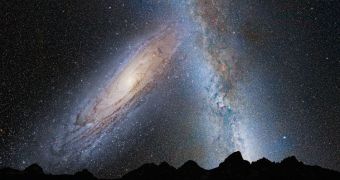In a study conducted using the NASA/ESA Hubble Space Telescope, researchers in the United States have discovered that the Milky Way will collide with its neighbor, M31 (the Andromeda Galaxy), in a head-on event.
Many astronomers believed that the two would only give each other a glancing blow, but the latest data obtained by investigators at the Space Telescope Science Institute (STScI), in Baltimore, Maryland, finally make the case for a head-on collision.
Data the team used to certify this were collected during a survey conducted using Hubble. Astronomers conducted a vast amount of measurements on M31, which is currently located around 2.5 billion light-years away. In about 5 billion years, it will be here.
The collision is unavoidable, experts say, explaining that the only way for it not to occur is for the laws of the Universe to break down. Andromeda is slightly larger than the Milky Way, but they are both spiral galaxies. After their collision, they will form a massive elliptical galaxy.
The nearby Triangulum Galaxy will most likely become a satellite of the newly formed cosmic structure. According to the new model, it would appear that Earth and the Sun will not be destroyed during the titanic collision.
However, it is possible that the solar system will be flung to a different galactic sector. “Our findings are statistically consistent with a head-on collision between the Andromeda galaxy and our Milky Way galaxy,” STScI investigator Roeland van der Marel explains.
“After nearly a century of speculation about the future destiny of Andromeda and our Milky Way, we at last have a clear picture of how events will unfold over the coming billions of years,” adds Sangmo Tony Sohn, who is also a STScI scientist.
Models based on the new Hubble data indicate that the two galaxies will first collide in about 4 billion years. It will then take an additional 2 billion years for the force of gravity to fully merge them into a single, massive elliptical galaxy.
Researchers say that there is a chance the Triangulum Galaxy (M33) will hit the Milky Way before Andromeda. However, there is no way of figuring that out for sure until it comes down to it.
“In the worst-case-scenario simulation, M31 slams into the Milky Way head-on and the stars are all scattered into different orbits,” Columbia University investigator, Gurtina Besla, goes on to say.
“The stellar populations of both galaxies are jostled, and the Milky Way loses its flattened pancake shape with most of the stars on nearly circular orbits. The galaxies' cores merge, and the stars settle into randomized orbits to create an elliptical-shaped galaxy,” the expert adds.
Details of the new study will appear in an upcoming issue of the esteemed Astrophysical Journal.

 14 DAY TRIAL //
14 DAY TRIAL //